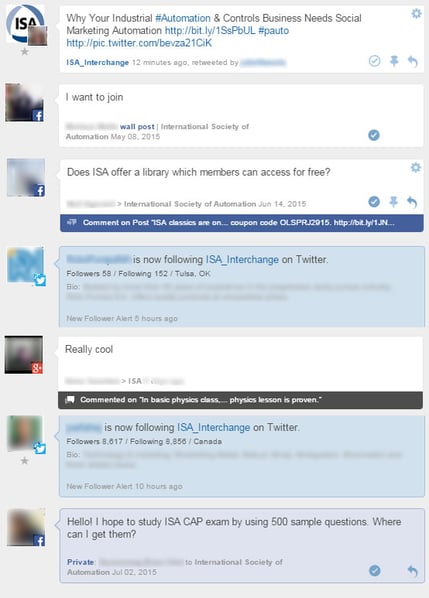This post is authored by Joel Don, ISA's community manager and a social media marketing & PR consultant.
Perhaps the single biggest obstacle to success in social media marketing is time – generally because we never seem to have enough of it. It’s no secret that effective social marketing demands a huge amount of your time. And if it always seems like others have more minutes in the day than you for posting interesting content in every time zone, more than likely their “secret” is in leveraging social media automation. So why don’t you do the same?
If you are already working in any facet of industry that relies on automation, instrumentation or controls technology, you probably don’t think twice about the cost benefits and efficiencies delivered by PLCs, SCADA systems and HMIs. Social media marketing automation tools can deliver the same value, and help you show up like an experienced social media marketer.
Automate your marketing outreach
You probably already have invested time and resources building a great website with plenty of customer-centric functionality. You’ve crafted white papers, eBooks, press releases, case studies, videos and collateral showcasing the benefits of your products and services. As you create new content and expand your marketing outreach to the social networks, social automation can help with research, content creation, scheduling, monitoring/listening , analytics and assessment of overall program effectiveness. Plus there’s follower management and engagement, i.e. your customer service function. Social automation can shave hours off that task as well.
Before I jump into some of the tools and strategies that I use for ISA’s social media channels, I want to address concerns that automation might seem to mechanize the process and remove the human component from social engagement. The concerns might be valid if you use automation simply as a way to broadcast one-way messages, i.e. post content blind and fail to interact with the community response. There are actually situations where you will absolutely want to skip the tools and use the “native” social network sites for posting content or updates. Native posting may give access to certain capabilities unavailable to third-party automation tools, and in certain situations tools do not post properly and can actually harm your brand. I’ll discuss a few of those social automation exceptions later or you can click here now to read some important exceptions to social automation.
For posting and scheduling content, Facebook has built-in scheduling for business pages. Twitter doesn’t. Neither does LinkedIn (groups or pages). Google Plus, Instagram and Pinterest? Nope. Why do you want to schedule posts? Post too much and all at once and your feeds might look like a spam flood. Scheduling gives you control, especially if you need to post globally to accommodate other time zones or want to post at optimal times. Social automation scheduling is like attaching a valve and a digital flowmeter to your content pipeline, and the operative analog concept is to achieve an optimal rate of flow over time to realize the maximum marketing benefit.
Automation saves time, scales for growth
For the most part, social automation maximizes your time and, as your online presence grows, can be a very efficient way to ensure maximum engagement when followers respond with mentions, shares, retweets and comments. I am going to break social media automation down into four key areas:
- Content research and development
- Posting and scheduling content
- Engaging with your community
- Measuring the impact of your social media outreach
The sheer volume of social automation tools can be overwhelming, and there’s no reason you have to try them all. Social media leaders tend to hopscotch from one tool to the next, extolling the virtues of every new shiny thing. It’s their job to review new options and tools. My experience is no single tool delivers everything you will need or want. Use the automation tools that work best for your workflow, not because you feel you have to join the “must have” bandwagon.
Most social automation tools are either free, free with reduced functionality or offer subscription prices ranging from approximately $100 to $1,000 per year, depending on scope of services, number of users, number of channels and simple vs. advanced analytics and metrics, etc.
The task of content research and development includes generation of your own social marketing content such as blogs, tweets, updates, infographics, still images, videos and podcasts. It also includes curating interesting content from a wide variety of sources and sharing it with your community as part of your best practices for a successful social media marketing program. When you share great third-party content, you enrich your followers and establish domain authority for your business brand.
Use the tools that match your workflow
There are a number of automation tools for curating or researching great content to share with your followers. Tools that consolidate your social media channels are especially helpful, and Hootsuite is a good choice for content discovery, posting, scheduling posts and tracking follower engagement. The free version is relatively feature-rich, and you’ll need paid versions to handle more than three social networks or optional analytics reporting add-ons. Hootsuite is an especially effective Twitter tool for tracking keywords, hashtags and your Twitters lists – filtered in column formats. Social media marketers at the top of their game are always looking to optimize keywords and produce content that will generate the most traffic. There are many keyword finders, and you might start with Google’s AdWords Keyword Planner. What about the best-performing content? Check out BuzzSumo, a tool that will show posts and articles that drive the most traffic on a specific topic as well as the top-performing content at any website, such as the content that gets the most clicks at your competitor’s blog or website. If you want to use automation tools to review your accounts and follower behavior, test drive Fanpage Karma, Followerwonk and TrackMaven.
I have also been using Buffer for years, and it actually complements my workflow alongside Hootsuite and features different levels of analytics depending on the paid subscription level. An additional tool that delivers scheduling, analytics and the very
 Consolidating comments, messages, shares, retweets, likes, follows, etc. in a single "inbox" tool significantly enhances community management and engagement. Source: Sprout Social
Consolidating comments, messages, shares, retweets, likes, follows, etc. in a single "inbox" tool significantly enhances community management and engagement. Source: Sprout Social
important function of engagement management is Sprout Social. While you can rely on native website notifications and emails to alert you to comments, direct messages, retweets, mentions, etc., a consolidated single inbox to monitor, respond and engage is the most efficient way to scale social media management with your expanding community of followers. That's where Sprout Social excels, in addition to being a robust overall social automation and analytics tool.
If Pinterest is part of your marketing mix, you’ll need Buffer for scheduling posts. Hootsuite and Sprout Social currently do not directly connect to the pinboard service. You can however schedule pins on Hootsuite by installing the Tailwind app directly from Hootsuite’s App Directory. Also, Buffer, Hootsuite and Sprout Social offer browser extensions, which automate the process of sharing articles and posts with a couple of clicks – no cutting and pasting links or text. A browser extension is a must-have automation function.
Although there is some duplication in my social automation toolbox, I find each tool offers a different way to view posts, analyze social media traffic, check performance metrics, discover new resources and build business relationships. They complement each other, but you may only need a single tool for your worlflow. If you are primarily focused on a single network such as Twitter, a dedicated automation tool such as SocialBro or TweetDeck might be the right ticket.
Exceptions to social automation
Hootsuite
Now the fine print. Watch out when using Hootsuite to post to LinkedIn. I recommend you avoid using the tool for posting to LinkedIn groups. It just doesn’t work right. The problem is LinkedIn groups contain three sections: discussions, promotions and jobs plus there are two data entry fields, “headline” and “details.” Hootsuite does not offer the option to post to sections and does not have separate fields for headline and details. The result: all posts end up in discussions, including your marketing notices and job announcements. It’s a constant headache for LinkedIn group managers. Repeated posting to the wrong LinkedIn group section can lead to account moderation or, worse, banishment from the group. If you use any automated posting tool for LinkedIn groups, which includes recruiting tools such as ZipRecruiter, Bullhorn and Monster, verify that you can select sections and data fields, and test check your posts to make sure they end up in the correct location and published as intended. Even though I often post with automation tools, I am also constantly visiting the native network sites to see how the content shows up, correcting as needed.
Facebook
You can use most automation tools to post videos to your Facebook business page. I am going to recommend that you instead use the native site for videos. Facebook offers enhanced capabilities if you post direct, with the key benefit of being able to add any external website link to each video. Sure you can sort of do that over at YouTube if you: 1) jump through several account verification and setup hoops and; 2) don't mind that you can only add links to "associated" websites and related subdomains for
which you are the verified owner and have registered each site link individually with your YouTube account prior to posting videos. Phew! Do you see the benefit of direct posting videos to Facebook if you plan to include an external link? Facebook wants you to upload videos directly (for obvious reasons), rather than have you use videos located at YouTube, Vimeo or other services. In exchange, at the end of your video you can send viewers to your main business website, a registration page, sales website, online marketing collateral page – anywhere you'd like and each video can have a different external link. You can even use bit,ly tracking links or any URL shortening service for that matter. This is a significant marketing benefit, worth the extra manual effort for every video where you'd like to send viewers to any landing page on an ad hoc basis.
There’s every reason to add automation tools to your industrial automation, controls or manufacturing business social media marketing program. If you have a favorite automation tool, please share it in the comments.






